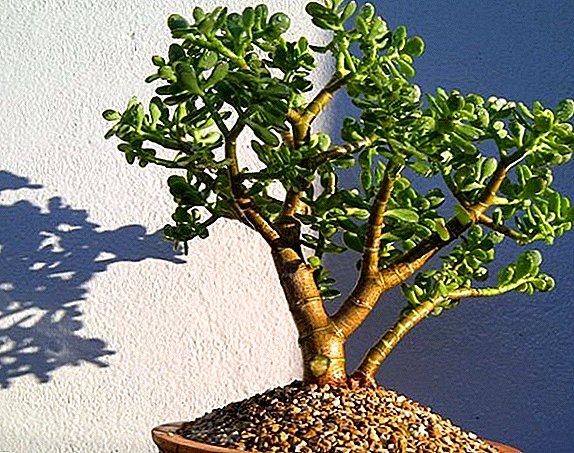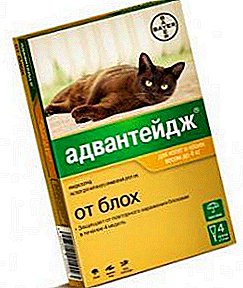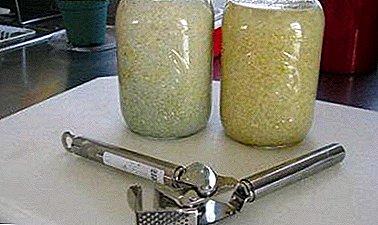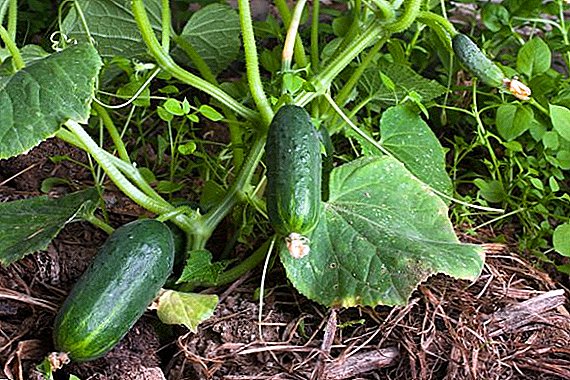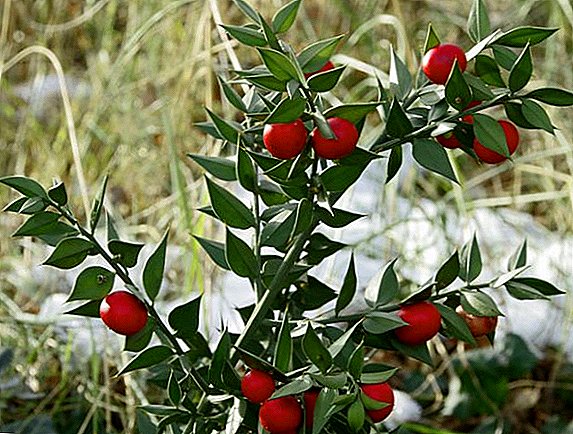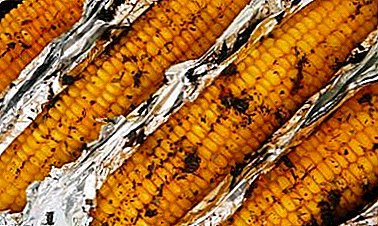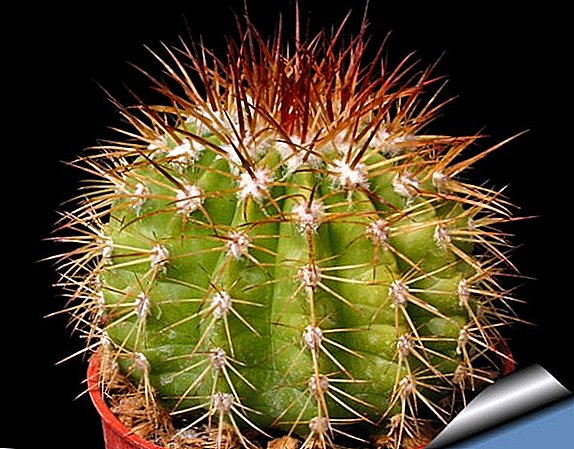 Fokin's ploskorez is a gardening tool, the main purpose of which is weeding and loosening.
Fokin's ploskorez is a gardening tool, the main purpose of which is weeding and loosening.
However, with it you can perform about two dozen operations in the garden and in the garden.
Ploskorezom can be cut and pull weeds. At the same time, the top layer of soil remains in place and loosens without reservoir circulation. This method of cultivation allows you to maintain its structure, preserves the inhabitants of the soil and does not require much effort. What is a flat cutter and how to use it correctly, we consider below.
Ploskorez Fokina: what is it
 Ploskorez - gardening tools, which consists of a curved plate and cutting surfaces. The blades of the cutting part must always be well sharpened to reduce the resistance of the soil and cut plants.
Ploskorez - gardening tools, which consists of a curved plate and cutting surfaces. The blades of the cutting part must always be well sharpened to reduce the resistance of the soil and cut plants.
Blades of a flat-cutter may be not sharp only in the case when the weeds are still young, with weak stems and the tool may not cut them, but pull out along with the root.
Today there are several types of flat-cutters for the suburban area:
- small - for quick and accurate weeding, sanding the soil, thinning seedlings;
- the large one is intended for the main works - forming and hilling of beds, mowing grass, weeding;
- "Sturdy" - has a shortened blade, which allows its use on clay soils;
- "Small shelf" - has a longer and narrow blade, used for accelerated weeding;
- “Large shelf” is an analogue of a large flat-cutter, but with a longer blade;
- "Moguschnik" - with a wide blade, used for earthing up of plants.
Did you know? There was a flat cut due to illness: Vladimir Fokin, after suffering a heart attack, could not do heavy labor. In order not to apply physical exertion, this light, strong and reliable assistant was invented by a gardener.
Assembly instruction for flat cutter
 The flat-cutter, when disassembled, consists of a bracket with a blade and two bolts (the handle is usually purchased separately). Of course, before you assemble Fokin's flat cutter, you need to read the instructions and focus on the drawing (video, photo).
The flat-cutter, when disassembled, consists of a bracket with a blade and two bolts (the handle is usually purchased separately). Of course, before you assemble Fokin's flat cutter, you need to read the instructions and focus on the drawing (video, photo).
Important! During assembly of the instrument, it is necessary to adhere to the requirements of safety regulations, because with careless use, sharp blades can cause injury.Although it is worth noting that the assembly of this tool is extremely simple: the flat cutter is mounted on a flat handle, having a cross-sectional shape with a rounded edge, which allows you to hold it in any position.
The cutting for a flat cutter must be of sufficient length so that you do not have to bend down low. The optimal length is 110-130 cm (for tall people - up to 160 cm).
Before using the Fokin flat-cutter, it must be adjusted to the height and manner of work. A small flat cutter has for this purpose two ways of fastening the blades to the handle (by applying the handle to the blade of one or another surface). The large flat cutter has 4 mounting methods: 2 are the same as the small one, and two more - due to the additional hole in the bracket.
It is recommended when attaching the flat cutter to the shank under the bolt washer to place a flat metal washer - this will prolong the service life of the tool.
Properly adjusted garden planer will reduce physical effort during deep tillage, loosening or hilling.
Important! The stalk of a flat cutter should be held with two hands, the distance between which should be 10-15 cm. The thumbs should be pointing upwards.
How to work flat-cutter Fokina
 Some gardeners are dissatisfied after working with the tool, since many do not know how to work correctly with the Fokin flat-cutter. As a rule, skills in working with other garden tools are also used when using a flat cutter.
Some gardeners are dissatisfied after working with the tool, since many do not know how to work correctly with the Fokin flat-cutter. As a rule, skills in working with other garden tools are also used when using a flat cutter.
When working with a flat cutter, there is no need to bend, you need to stand straight, holding the tool like a scythe.
Soil loosening
Did you know? At the beginning of the 20th century, Ivan Ovsinsky several times increased the yield without mineral fertilizers, using surface loosening and not removing straw from the ground.Loosening and weeding is performed by the wide side of the blade - it enters the soil at an optimum distance (about 5 cm) and with a slight movement stretches toward itself or along the bed. In this case, the tool resembles a braid. The soil should not be prigrebatsya, and stay in place, loosened.
It is recommended to carry out weeding at the beginning of the growth of weeds, when it is easier to cope with them, not allowing them to grow.
Important! The blade should enter the ground at a small angle with a sharp end, almost parallel to the surface, and not on top and flat.Thus, with the help of Fokin's flat-cutter, knowing how to work with it, one can cultivate non-sown beds, potato, tomato, cucumber and cabbage aisles.
Formation of ridges
 Another function that the planer can perform is the formation of beds. Moving on one side, on the other, the soil and cut weeds are scooped up on a bed. Walking in this way on one side, they move on to the other, and they scoop up the bed from the other side.
Another function that the planer can perform is the formation of beds. Moving on one side, on the other, the soil and cut weeds are scooped up on a bed. Walking in this way on one side, they move on to the other, and they scoop up the bed from the other side.
The edges of the beds should remain parallel and straight. In wet areas, beds are made higher by performing flat-cutting intermittent, jerking movements, throwing earth on the bed.
The width for subsequent work with a Fokin flat-cutter should be large - 1 m.
Cutting grooves
To level the grooves, the blade is buried flat to a depth of 1-2 cm. Flat cutters are driven like a rake, along the garden, onto themselves smoothly or with a slight acceleration. Lumps at the same time loosened, and the beds are aligned.
Important! If this operation is carried out, moving each time along the north side (so that the slope of the bed is directed south), it is possible to grow vegetables in earlier periods.
Hilling of plants
 The next process that will facilitate this tool is hilling. How does Fokin's flat cutter work in this case? The wide part of the blade is lowered to a shallow depth in the ground. After gentle motions float the earth.
The next process that will facilitate this tool is hilling. How does Fokin's flat cutter work in this case? The wide part of the blade is lowered to a shallow depth in the ground. After gentle motions float the earth.
Work as the tool a hoe.
Weed removal
When loosening the soil and the formation of beds, young weeds are destroyed almost completely (70-80%). If these operations are carried out at intervals of 7-10 days, then weeds can be completely destroyed.
However, if you are late with the treatment, you will have to use a flat cutter to remove weeds. How to work with a Fokin flat cutter in order to properly carry out the procedure of ridding our cultures of wild relatives? It's simple: the blade of the tool is gently introduced to a depth of 1-3 cm (the soil should be moderately wet).
If the ground is dry, the grown weeds are pruned by a sharp movement of a flat-cutter or, according to the principle of operation, with a blade with a depth of 1-3 cm.
A week later, the operation should be repeated to remove the weeds that had taken root. In any case, Fokin's flat cutter (of course, if you know how to use it), will eliminate the need to gather weeds from the garden.
 If the weeds are rooted, the narrowed end of the blade pierces under the weed at an angle of 60 degrees, and jerked out. Ploskorez allows you to do this so jewelery that the neighboring plants are not damaged.
If the weeds are rooted, the narrowed end of the blade pierces under the weed at an angle of 60 degrees, and jerked out. Ploskorez allows you to do this so jewelery that the neighboring plants are not damaged.
Ploskorezom Fokina can be carried out and other operations: distribute the fertilizer on the beds, sprinkle the seeds, stir or rake hay, etc.
Fokin's flat cutter: sharpening and storage
Any tool will last longer with proper care. Like any tool with cutting parts, the Fokin flat cutter needs sharpening. This is done, as a rule, as necessary, processing blades 1-2 mm from the edge. At the same time overheating should be avoided, which reduces the strength of the blade. When honing a tool, it is important not to dull the corners.
Did you know? The more organic matter in the top layer of soil, the less flattened dips.You can sharpen a flat cutter with the usual fixtures, specially provided for this purpose:
- sharpeners;
- bars;
- emery circles;
- grinder machines.
- On the cutting edge, you only need to grind the chamfer-bevel. If you grind off the front surface, the sharpness angle of the blade increases.
- The appearance of the blade tells us where to sharpen. As a rule, the tool tip is grinded.
- The pressure of the flat cutter should be minimal so that the sharpening process takes place without heating.
 After the end of the gardening season the flat cutter must be lubricated and put into the sand with used engine oil (to prevent rusting).
After the end of the gardening season the flat cutter must be lubricated and put into the sand with used engine oil (to prevent rusting).Ploskorez - a great achievement in agriculture. This is truly a universal tool for the garden. If you doubt which tool: shovel, rake or flat cutter is better, we advise you to experiment - only practice can show all the positive aspects of any tool.



